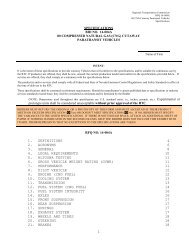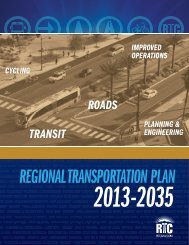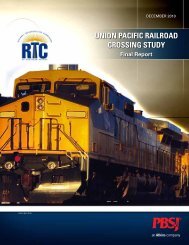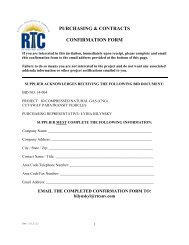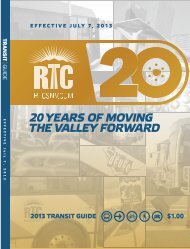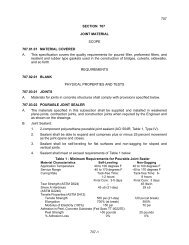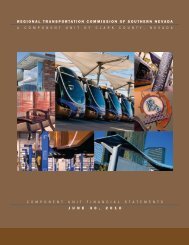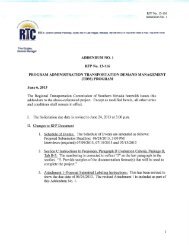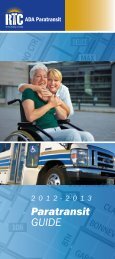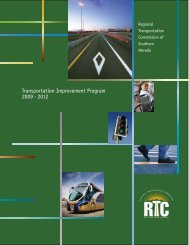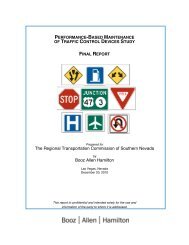(Blue Diamond Road) Corridor Study - Regional Transportation ...
(Blue Diamond Road) Corridor Study - Regional Transportation ...
(Blue Diamond Road) Corridor Study - Regional Transportation ...
You also want an ePaper? Increase the reach of your titles
YUMPU automatically turns print PDFs into web optimized ePapers that Google loves.
2. Current Conditions of <strong>Study</strong> Area RTC SR-160 <strong>Corridor</strong> <strong>Study</strong><br />
EXHIBIT 2-14: 10-year Trend in Average Daily Traffic<br />
30,000<br />
Average Daily Traffic<br />
25,000<br />
20,000<br />
15,000<br />
10,000<br />
5,000<br />
0<br />
Decatur<br />
Rainbow<br />
Pahrump Valley<br />
Rd<br />
1995<br />
1996<br />
1997<br />
1998<br />
1999<br />
2000<br />
2001<br />
2002<br />
2003<br />
2004<br />
YEAR<br />
Source: Nevada Department of <strong>Transportation</strong> (NDOT),<br />
2003 Traffic Counts for the Southern Nevada Area<br />
Major arterial streets and highways carry the largest share of through or long-distance<br />
travel. Along the SR-160 corridor, one of the biggest factors contributing to peak traffic<br />
congestion cause by heavy volumes on SR-160 is the incomplete nature of the major<br />
arterial network in the southwest Clark County area.<br />
Because of gaps in several major<br />
north-south arterials approaching SR-160, traffic that would otherwise circulate through a<br />
more integrated street network is funneled onto SR-160. Currently, there are critical gaps<br />
in several major north-south arterials, including Durango, Fort Apache, Buffalo, Jones and<br />
Valley View.<br />
substitutes to SR-160.<br />
In addition, there are no viable east-west arterials that can serve as<br />
Collector streets provide direct service to residential areas, local parks, churches, etc. To<br />
preserve the amenities of neighborhoods, they are usually spaced at about half-mile<br />
intervals to collect traffic from local access streets and convey it to major and minor arterial<br />
streets and highways. The collector streets within the SR-160 corridor provide access to SR-<br />
160 and other major arterials. Again, because of the disconnected nature of the circulation<br />
system, traffic is funneled to SR-160 with few viable alternatives.<br />
Local access streets are the smallest class of roadway and those not selected for inclusion in<br />
the arterial or collector classes. They allow access to individual homes, shops, and similar<br />
traffic destinations. Through traffic should be discouraged by using appropriate geometric<br />
2-23



